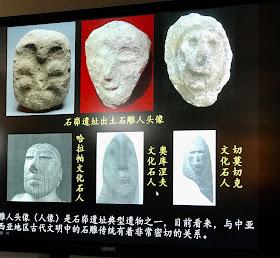 |
| Shimao dig |
Locals knew of its presence 100 years ago but the technology was not here to investigate. Excavation did not begin until 2012 and will take at least 50 years to complete.
Definitely off the tourist track, a delegation in a variety of vehicles drove us up a track too narrow for our bus. We wove across bare, windswept hills and mesas, past a fenced off area to our right and a large, tarp-surrounded pavilion-like structure to the left.
 |
| Palace excavation |
 |
| Associate Researcher Shao Jing |
Archaeologists - there are 50 people in all responsible for the site - have found evidence of a large outer city surrounding a higher, smaller inner city, pond and tower.
"At the top we believe they have found a palace. We are close to the rammed earth foundation. Similar sites are found in India and Iran," said Shao.
 |
| Dholavira, India |
Others include Uruk of cylander seals and Gilgamesh fame in what is now Iraq; and Hatusa, which became the Hittite capital in Turkey. Similarities also were found in Jericho, Jordan.
 |
| Uruk, Iraq |
Beyond that, when materials and objects from each site were found in the others it further indicated trade and communications between them. For example, the ivory and crystal being found at Shimao.
"Connecting the Middle East and the Northwest China site is a very important discovery," Shao said.
So much so that they plan to apply for UNESCO World Heritage status in 2019. The site is not open to the public but Shao hoped it might be in two to three years.
Let's see, given the wait for UNESCO status and the time to build facilities, mark your calendars for 2030. Another Chinese archaeological museum like the one we saw near Hancheng will be well-worth the trek.







No comments:
Post a Comment